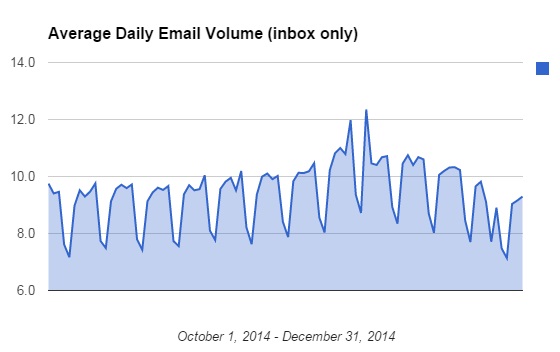Despite warnings over a holiday blizzard of marketing messages or a consumer backlash against over-eager inbox advertisers, the Christmas period was actually a strong time for email marketing, according to new data.
Email intelligence companyReturn Path’s analysis of 2 million active subscribers’ email engagement between October and December 2014 reveals an intriguing relationship between consumers and popular brands that contradicts some long held beliefs about inbox overload and the Christmas shopping season.
The Inbox is Commercial
Only 18% of messages in the typical inbox are personal, peer-to-peer communications. The rest are commercial, and most (53%) are promotional. That means that email marketing messages include offers, newsletters, marketing content, and other non-transactional messages from consumer brands.

During the quarter, that meant that the typical inbox received roughly two personal messages, five promotional messages, and two other commercial messages per day – around nine altogether (9.4). Volume climbed steadily in mid-November to a high of 12 daily messages on cyber Monday, with promotional mail making up roughly all of the additional volume. The daily holiday increase was far less pronounced on other days, though: between November 24 and December 23 the typical inbox received ten messages, six of which were promotional.
More email went directly to subscribers’ spam or junk folders during the quarter, at an average of twelve (12.4) messages per day. There was no meaningful increase in the number of messages that went to consumers’ spam folders during the holiday peak, either. If there was a glut of spam among the holiday messages, it never made it to mailboxes.
Most People Aren’t Average
Of course, few subscribers are typical. One subscriber in seven inboxes (14%) received more than 20 email messages per day. Nearly half (46%) receive five or fewer daily messages. In fact only 25% of subscribers fell within the average range, receiving 6-10 daily messages delivered to the inbox.
Engagement Holds Steady During the Holidays
Neither did they complain about increases in commercial mail; in fact, when they complained about unwanted messages, the senders were rarely retail brands. For every 10,000 messages classified as “shopping”, subscribers lodged 63 “this is spam” complaints. This rate was lower than messages classified as travel, finance, news, and entertainment.

Methodology
To profile consumer email usage and engagement during Q4-2014, Return Path analysed the anonymous, aggregated mailbox interactions of a representative sample of 2 million actual subscribers with more than 3.8 billion email messages received between 1 October and 31 December 2014.
Source: www.returnpath.com
